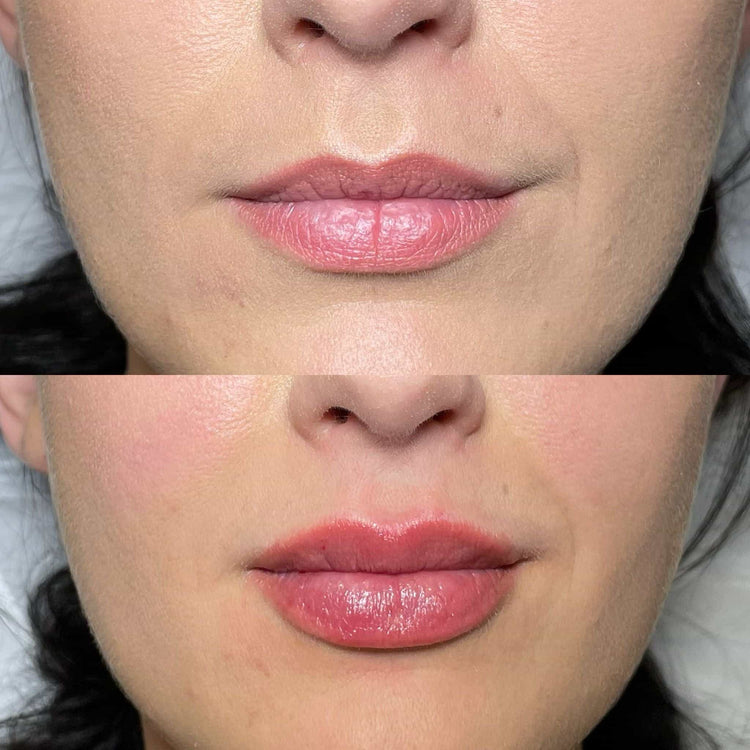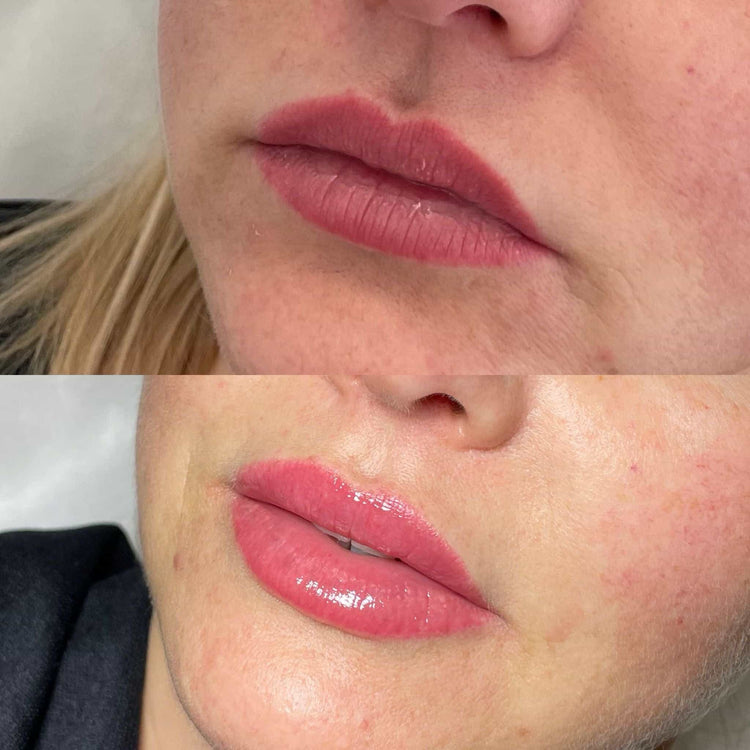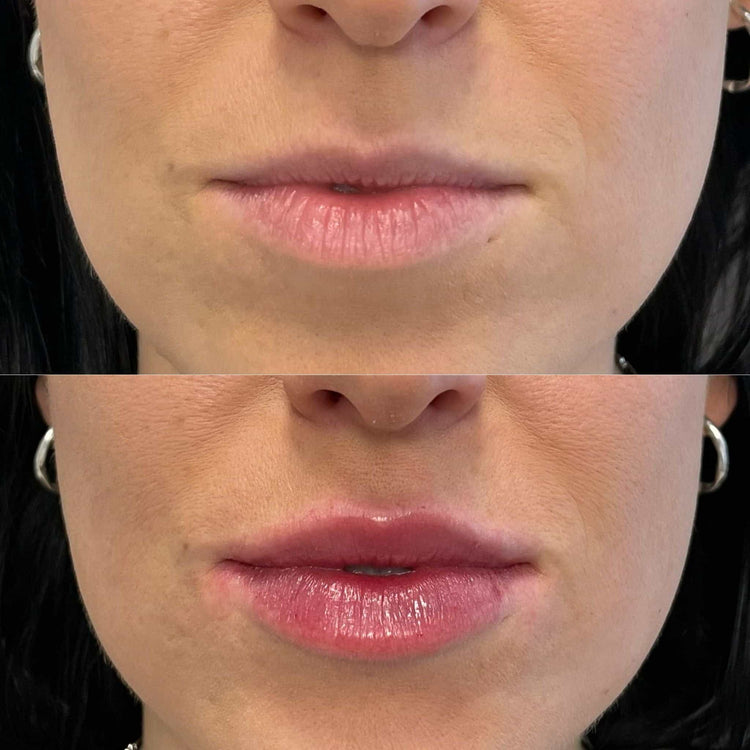Types of Lip Filler Materials
Lip fillers have become increasingly popular, offering a non-surgical way to enhance lip size and shape. But with various types of filler materials available, it’s crucial to understand the differences and safety profiles before making a decision.
Hyaluronic Acid Fillers
Hyaluronic acid is a naturally occurring substance in the body that helps to retain moisture and provide volume. Hyaluronic acid fillers are the most common type of lip filler used today. They are made from synthetic hyaluronic acid and work by attracting and holding water, thereby plumping up the lips. Hyaluronic acid fillers are generally considered safe when administered by a qualified and experienced practitioner.
Non-Hyaluronic Acid Fillers
While hyaluronic acid is the most common material used in lip fillers, there are other options available, including non-hyaluronic acid fillers. These fillers typically consist of synthetic polymers like polymethylmethacrylate (PMMA), calcium hydroxylapatite (CaHA), or poly-L-lactic acid (PLLA).
Each of these materials has its own unique properties and potential risks and benefits. For example, PMMA is a permanent filler that can provide long-lasting results, but it carries a higher risk of complications such as granulomas.
Procedure and Risks Involved in Lip Filler Treatments
Before undergoing lip filler treatment, it’s essential to understand the procedures involved and the potential risks associated with each type of filler. The procedure typically involves injecting the chosen filler material into specific areas of the lips to enhance their size and shape. Risks can range from mild side effects like swelling, bruising, or tenderness to more serious complications such as infection, allergic reactions, or vascular occlusion (blockage of blood vessels).
Consultation and Assessment
A consultation with a qualified practitioner is crucial before undergoing any lip filler treatment. During the consultation, the practitioner will assess your individual needs and medical history, discussing your desired outcome and any concerns you may have. They will also explain the different types of fillers available, outlining their properties, potential benefits, and associated risks.
Based on your consultation and assessment, the practitioner will recommend a suitable filler and treatment plan tailored to your specific needs. It’s important to ask questions and ensure you fully understand the procedure and potential risks before making a decision.
The actual lip filler treatment is generally performed in an outpatient setting using local anesthesia. The practitioner will inject the filler material into precise locations within the lips, using fine needles to create the desired shape and volume. The entire procedure typically takes around 30 minutes to an hour.
Treatment Process
Lip filler treatments are a popular cosmetic procedure that can enhance lip size and shape. They involve injecting a substance, most commonly hyaluronic acid, into specific areas of the lips. Hyaluronic acid is naturally found in the body and attracts water, plumping up the lips.
The process typically begins with a consultation where a qualified practitioner will assess your desired outcome, medical history, and any concerns you may have. They will discuss different types of fillers available, their properties, benefits, and potential risks.
During the treatment, local anesthesia is used to numb the area. The practitioner will then inject the filler material using fine needles into precise locations within the lips to achieve the desired shape and volume.
Potential risks associated with lip filler treatments include swelling, bruising, tenderness, infection, allergic reactions, and vascular occlusion (blockage of blood vessels). It’s essential to choose a qualified and experienced practitioner who follows sterile procedures to minimize these risks.
Potential Side Effects and Complications
Lip fillers are injections of substances, typically hyaluronic acid, used to enhance lip size and shape. Hyaluronic acid is naturally found in the body and attracts water, resulting in plumper lips.
The procedure involves injecting the filler material using fine needles into specific areas of the lips under local anesthesia. The entire process usually takes around 30 minutes to an hour.
Potential side effects include swelling, bruising, tenderness, redness, and itching. These are usually temporary and subside within a few days.
More serious complications, though less common, can occur. These include infection, allergic reactions, and vascular occlusion (blockage of blood vessels), which can be very dangerous.
It’s crucial to choose a qualified practitioner who uses sterile techniques and adheres to proper protocols to minimize risks.
During a consultation, a practitioner will assess your individual needs, discuss desired outcomes, review your medical history, and explain different filler types, their properties, benefits, and potential risks.
Choosing a Qualified Practitioner
When considering lip fillers, choosing a qualified practitioner is paramount. Their expertise ensures the safety and effectiveness of the procedure.
Qualifications and Experience
When making the decision to undergo lip filler treatment, it’s crucial to choose a practitioner who possesses the necessary qualifications and experience.
Look for practitioners with specialized training in aesthetic medicine or cosmetic injectables. They should have a thorough understanding of facial anatomy, injection techniques, and potential complications associated with lip fillers.
Inquire about their experience performing lip filler procedures, the number of patients they’ve treated, and any certifications they hold.
Furthermore, it’s essential to ensure that the practitioner practices in a sterile environment and follows strict infection control protocols.
Clinic Standards and Regulations
Choosing a qualified practitioner is paramount when considering lip fillers. Practitioners should have specialized training in aesthetic medicine or cosmetic injectables, with a thorough understanding of facial anatomy, injection techniques, and potential complications.
Inquire about their experience performing lip filler procedures, the number of patients they’ve treated, and any certifications they hold.
Ensure they practice in a sterile environment adhering to strict infection control protocols.
Clinic standards and regulations play a vital role in ensuring patient safety. Reputable clinics will comply with all relevant guidelines and standards set by governing bodies, such as the General Medical Council (GMC) in the UK.
These standards encompass various aspects, including practitioner qualifications, sterile practices, aftercare instructions, and handling of medical waste.
Before undergoing treatment, it’s advisable to inquire about the clinic’s accreditation, licensing, and adherence to safety protocols.
Reviews and Testimonials
When considering lip fillers, choosing a qualified practitioner is paramount. Their expertise ensures the safety and effectiveness of the procedure.
Look for practitioners with specialized training in aesthetic medicine or cosmetic injectables. They should have a thorough understanding of facial anatomy, injection techniques, and potential complications associated with lip fillers.
Inquire about their experience performing lip filler procedures, the number of patients they’ve treated, and any certifications they hold.
Furthermore, it’s essential to ensure that the practitioner practices in a sterile environment and follows strict infection control protocols.
Aftercare Instructions and Expectations
Understanding aftercare instructions is crucial for maximizing your lip filler results and ensuring a smooth recovery. These guidelines will help minimize potential side effects, promote healing, and prevent complications.
Immediate Post-Treatment Care
Immediately following the procedure, you may experience some swelling, bruising, or tenderness around the lips. Apply ice packs to the area for 15-20 minutes at a time, several times a day, to reduce swelling.
Avoid touching or rubbing your lips excessively as this can irritate the treated area and increase the risk of infection.
Refrain from activities that could cause trauma to your lips, such as strenuous exercise or vigorous facial massage, for at least a few days.
Your practitioner will likely advise you to avoid certain medications, including aspirin and ibuprofen, as they can increase bleeding and bruising.
It’s important to keep your lips hydrated by drinking plenty of water.
Follow any specific instructions provided by your practitioner regarding the use of lip balms or creams, as some products may irritate the treated area.
Avoid sun exposure and wear sunscreen daily, as your lips may be more sensitive after treatment.
You should schedule a follow-up appointment with your practitioner to monitor your healing process and address any concerns.
Long-Term Maintenance and Follow-Up Appointments
Aftercare instructions are essential for ensuring optimal results and minimizing potential complications from lip filler treatments.

- Immediately Following the Procedure: Apply ice packs to reduce swelling.
- Avoid Touching or Rubbing: This can irritate the area and increase the risk of infection.
- Limit Activities: Avoid strenuous exercise or vigorous facial massage for a few days.
- Medication Adherence: Follow your practitioner’s advice regarding medications, such as avoiding aspirin or ibuprofen which can increase bleeding and bruising.
- Hydration is Key: Drink plenty of water to keep your lips hydrated.
- Sunscreen Protection: Lips are more sensitive after treatment, so protect them from sun exposure.
- Follow-Up Appointments: Schedule appointments as instructed by your practitioner to monitor healing and address any concerns.
Long-term maintenance of lip filler results involves understanding the lifespan of different fillers. Hyaluronic acid fillers typically last for several months to a year, depending on factors like individual metabolism, lifestyle, and the type of filler used.
To prolong your results, avoid excessive sun exposure, as UV rays can break down hyaluronic acid.
Maintain good hydration by drinking plenty of water and using moisturizing lip balms.
Follow-up appointments with your practitioner are crucial for monitoring the longevity of your lip fillers.
- Assessment: Your practitioner will assess the volume and shape of your lips to determine if any touch-ups are needed.
- Top-Ups: If necessary, they may inject additional filler to maintain desired fullness and shape.
- Addressing Concerns: You can discuss any concerns or questions you have about your treatment results or potential side effects.
Legal Requirements and Regulations in the UK
The UK has a robust regulatory framework governing cosmetic procedures, including lip fillers. These regulations are designed to ensure patient safety and protect consumers from unqualified practitioners. The use of certain substances in lip fillers is strictly regulated by the Medicines and Healthcare products Regulatory Agency (MHRA). Practitioners must be qualified medical professionals, such as doctors, dentists, or registered nurses, with appropriate training and experience in aesthetic medicine.
Licensing and Accreditation of Clinics
The UK has a comprehensive regulatory framework governing cosmetic procedures like lip fillers. This system is designed to ensure patient safety and protect consumers from unqualified practitioners. The Medicines and Healthcare products Regulatory Agency (MHRA) strictly regulates the use of substances in lip fillers. To legally administer these treatments, practitioners must be qualified medical professionals such as doctors, dentists, or registered nurses with specific training and experience in aesthetic medicine.
Clinics offering cosmetic procedures, including lip fillers, are also subject to regulations. These regulations encompass aspects like practitioner qualifications, sterile practices, aftercare instructions, and the handling of medical waste.

To find a clinic that meets these standards, it’s important to look for accreditation from recognized bodies such as the Joint Council for Cosmetic Practitioners (JCCP).
Mandatory Training for Practitioners
The UK has stringent regulations surrounding lip fillers and other cosmetic procedures to ensure patient safety. Practitioners administering these treatments must meet specific qualifications and adhere to strict protocols.
To legally perform lip filler procedures, practitioners need to be qualified medical professionals such as doctors, dentists, or registered nurses. They must also possess specialized training and experience in aesthetic medicine.
The Medicines and Healthcare products Regulatory Agency (MHRA) strictly regulates the substances used in lip fillers. Clinics offering these procedures are subject to regulations covering practitioner qualifications, sterile practices, aftercare instructions, and medical waste management.
When seeking lip filler treatment, it’s essential to choose a clinic accredited by reputable bodies like the Joint Council for Cosmetic Practitioners (JCCP) to ensure they meet the required standards.
Reporting of Adverse Events
Reporting adverse events following cosmetic procedures, including lip fillers, is crucial in ensuring patient safety and improving healthcare practices. In the UK, there are established systems and guidelines for reporting such events.
The Medicines and Healthcare products Regulatory Agency (MHRA) is the primary body responsible for overseeing the safety of medicines and medical devices in the UK, including cosmetic fillers. They have a system for reporting adverse drug reactions, which encompasses cosmetic procedures and their associated complications.
Healthcare professionals, including doctors, dentists, and nurses who administer lip fillers, are legally obligated to report any suspected adverse events or serious side effects related to these treatments to the MHRA through their Yellow Card Scheme. Patients can also directly report adverse events to the MHRA.
Reporting adverse events allows for the identification of potential safety issues with specific products or treatment techniques. This information is used by regulatory bodies to assess the risks and benefits of cosmetic procedures, issue warnings or recommendations, and ultimately improve patient safety.
Cost and Duration of Lip Fillers
The cost of lip fillers in the UK can vary depending on factors such as the practitioner’s experience, the amount of filler used, and the location of the clinic. Typically, you can expect to pay between £250 and £600 for a single treatment session.
Duration of lip filler procedures is generally short, lasting around 30 minutes to an hour. This includes consultation time, preparation, injection process, and aftercare instructions.
Pricing Factors and Variations
The cost of lip fillers in the UK can vary depending on several factors. The practitioner’s experience and qualifications, the amount of filler used, the specific type of filler chosen, and the location of the clinic all contribute to the overall price.
As a general guide, expect to pay between £250 and £600 for a single treatment session.
The duration of a lip filler procedure is relatively short, typically taking around 30 minutes to an hour. This includes the consultation, preparation, injection process, and any post-treatment instructions provided by the practitioner.
Longevity of Results

The cost of lip fillers in the UK can vary significantly depending on factors like the practitioner’s experience, the amount of filler used, the specific type of filler, and the clinic’s location. Prices typically range from £250 to £600 for a single treatment.
A typical lip filler session takes around 30 minutes to an hour. This includes the consultation, preparation, injection process, and aftercare instructions provided by the practitioner.
The longevity of lip filler results varies depending on the type of filler used and individual factors like metabolism and lifestyle. Hyaluronic acid fillers generally last between six months to a year.
Alternatives to Lip Fillers
There are several alternatives to lip fillers available for those seeking fuller lips without injections. These options include:
* **Over-the-counter lip plumpers:** These products often contain ingredients like menthol or cinnamon that create a temporary illusion of fullness by increasing blood flow to the lips.
* **Lip enhancing cosmetics:** Lip glosses, tinted balms, and pencils can be used to define and enhance the shape of the lips, creating an appearance of volume.
* **Natural remedies:** Some individuals find that applying natural ingredients like honey or avocado to their lips helps to hydrate and plump them slightly.
It’s important to note that these alternatives may provide only temporary results and are generally less effective than lip fillers in achieving significant volume enhancement.
Permanent Lip Tattoos
Alternatives to lip fillers, particularly permanent lip tattoos, involve different approaches to enhancing lip appearance.
Permanent lip tattooing, also known as semi-permanent makeup or lip blushing, involves using pigments injected into the dermal layer of the lips to create a lasting color and shape enhancement.
While permanent, lip tattoos can be less dramatic in volume than fillers.
They aim to define the lip line, add subtle fullness, and enhance natural lip color.
A skilled cosmetic tattoo artist will carefully assess your desired outcome and customize the design to suit your individual features and preferences.
Dermal Fillers for Other Areas
Alternatives to Lip Fillers
- Lip Plumping Products: Over-the-counter lip plumpers containing menthol or cinnamon can temporarily increase blood flow, creating a fuller appearance.
- Cosmetic Enhancement: Lip glosses, tinted balms, and pencils can define the lip shape and create an illusion of volume.
- Natural Remedies: Some individuals use honey or avocado to hydrate and potentially slightly plump lips.
Dermal fillers are used for various areas besides lips, such as:
- Nasolabial Folds (Smile Lines): Fillers can reduce the appearance of lines that run from the nose to the corners of the mouth.
- Marionette Lines: These vertical lines extending down from the corners of the mouth can be minimized with fillers.
- Cheek Augmentation: Fillers can add volume to the cheeks, enhancing facial contours.
- Jawline Definition: Fillers can create a more defined jawline by adding volume to the chin and jaw area.
- Facial Contouring: Fillers can be strategically placed to sculpt specific areas of the face, achieving desired contours.
Enhance your natural beauty with lip fillers from Dr. Laura Geige at It’s Me & You Clinic
- Profhilo Treatment Near Bourne, Surrey - November 3, 2025
- Polynucleotides Injectables Near Ockley, Surrey - November 2, 2025
- Polynucleotides Injectables Near Camberley, Surrey - November 1, 2025
